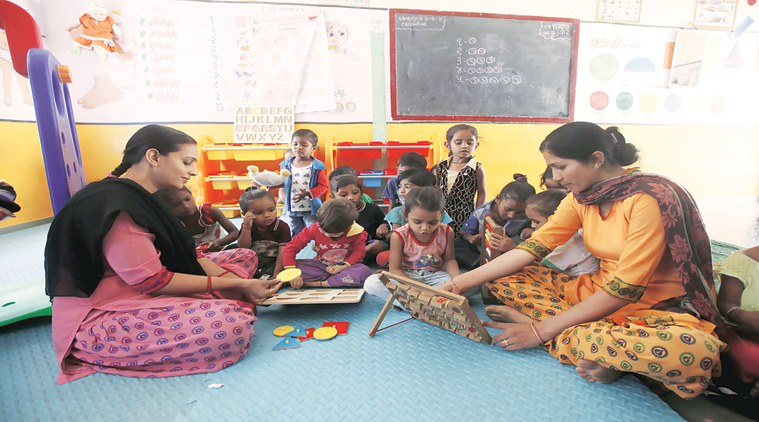Hardlook: Anganwadis vs anganwadis
With the recent case of caste discrimination at an anganwadi centre in Patan district reported by this paper and the corrective measures taken by the state government that followed after the report, The Indian Express visits several anganwadi centres across the state for a reality check.
 IT’S AROUND 9:30 am and Pankaj Parmar, a khaki-clad safai karmachari, donning the red-white-green-coloured Amul Dairy cap, stands opposite the gate of anganwadi centre No. 56, which was completed around a year ago, in Tulsibaug area of the posh Sadhu Vasvani Road in Rajkot. Half a dozen fresh cakes of dung are placed near the compound wall of the anganwadi. A woman is sweeping the street, but she can’t sweep the dung cakes away. “Many maldharis (cattle-herders) live in this locality and they plaster their dung cake on the wall of this anganwadi for drying. This was creating hygiene problem. So, a few days back, our ward officer got the wall cleaned with the help of fire department and posted me here as a security guard. I stand on duty between 6-11 am when maldhari women make dung cakes. They wouldn’t listen to anybody else, but the one in khaki uniform,” says Parmar.
IT’S AROUND 9:30 am and Pankaj Parmar, a khaki-clad safai karmachari, donning the red-white-green-coloured Amul Dairy cap, stands opposite the gate of anganwadi centre No. 56, which was completed around a year ago, in Tulsibaug area of the posh Sadhu Vasvani Road in Rajkot. Half a dozen fresh cakes of dung are placed near the compound wall of the anganwadi. A woman is sweeping the street, but she can’t sweep the dung cakes away. “Many maldharis (cattle-herders) live in this locality and they plaster their dung cake on the wall of this anganwadi for drying. This was creating hygiene problem. So, a few days back, our ward officer got the wall cleaned with the help of fire department and posted me here as a security guard. I stand on duty between 6-11 am when maldhari women make dung cakes. They wouldn’t listen to anybody else, but the one in khaki uniform,” says Parmar.
As the morning progresses, Vala Chohla, a maldhari living in the area, reaches the anganwadi with his four-year-old son, Viram, holding his finger. He has his younger son, one-and-a-half-year-old Yuvraj, up in his arms. “I’m illiterate, but my wife Radha has received primary education. We rear seven cows to run the family and have been living in this area for the last one year. Niruben and Varshaben take good care of my son and, therefore, I send him here,” says Chohla, a native of Jasdan taluka.
Chohla is followed by Anita Pariyar. Originally from Nepal, Pariyar has been living as the tenant of one Ghela Bharvad in the locality. She has come to drop her son, Rohit (5), to the anganwadi while her elder son, Rahul (9), has gone to school. “My husband, Jugga Singh, is an alcoholic and does precious little. I work as domestic help for 10 families to provide for my two sons and husband. This anganwadi takes good care of Rohit,” says the 40-year-old mother.
At around 10 am, Rama Joshi, an auxiliary nurse and midwife working for Rajkot Municipal Corporation (RMC), arrives on her scooter, with his son, Herry (4), and co-worker, Lata Purohit. “I have known the anganwadi worker here for the last five years when we used to live in government-built quarters in this area. She is an excellent caretaker. So, even though we have now shifted to Gandhigram area, I bring my son here,” says Joshi. Her husband, a taxi driver, is out with their car, ferrying people across the city.
Inside the one-room pukka building of the anganwadi, which was completed around five months back, about 40 odd children are sitting in small chairs. The place — clean and tidy — is redolent of phenyl. A copper pot, filled up with drinking water, occupies the platform of the kitchen. Tins containing pulao, steamed gram and sheera — a recipe made from wheat flour, jaggery and ghee and sent from the central kitchen of the RMC — are placed beside the pot. The store room is full of bags containing balbhog, premix sukhdi, sheera and upma. A door in the kitchen gallery opens near an underground water tank. An alley leads to two toilets. One of them is locked, the other functional.
As Niru Vaghela, the anganwadi worker, makes signs with the help of her hands, children sitting in the chair burst into collective singing, reciting “K kalam no k” — the first of Gujarati alphabets. Four other children are busy filling colours in their picture books. “Having a degree in Home Science, I was working as a teacher in a private secondary school, but took up this job five years ago as I was not getting good salary. I love this work and parents have also been cooperative. I seek contribution from parents, explaining them how they would save thousands in school fees if their children were groomed here properly and manage to secure admission in good private school through RTE. Though it’s not part of my job, I help parents fill up RTE forms and get their children admitted to top schools,” says Vaghela, 30.
The locality is dominated by maldharis, Patels and Brahmins. Vaghela belongs to the scheduled caste, but she says nobody has ever “raised an eyebrow”. The centre has 30 girls and 27 boys. Vaghela says 55 children, on an average, attend the centre every day. The children chant English alphabets when prompted by Vaghela. They even reel off names of the days of the week when asked. Vaghela’s helper, Varsha Vadoliya, often helps children use the washroom. “The only thing lacking here is submersible pump to pump water in the overhead tank so that the toilet can be flushed properly. Officers have assured us it will be done soon,” she adds.
The other anganwadi
The Tulsibaug anganwadi stands in sharp contrast with the ones in Valmiki Vadi, a relatively poor neighbourhood on Jamnagar Road, dominated by Dalits and Muslims. The two anganwadi centres — No.73 and No. 45 — are functioning out of an RMC community hall. While anganwadi No. 73 caters to Dalit children living in government quarters built for rehabilitating slum-dwellers, anganwadi No. 45 covers Bhistiwad area of Muslims.
Both centres have enrolled around 30 children each. But on the day The Indian Express visits them, hardly 20 children are present at both centres put together.
Alfaz, 4, is telling a story to the rest of the children, who are all screaming and cheering. Bharti Vala, 41, the worker at the centre No. 45, is trying to control them with a small cane even as her helper, Zarina Kherani, catches those who try to wander away and puts them back on two tarpaulin sheet laid as carpet. While the floor of the hall is large, there is no water stand. Children have to drink water from a tap fixed at a place essentially meant for doing dishes. There are two toilets, stinky and, therefore, locked. “This community hall doesn’t have an underground tank or an overhead tank. We cannot flush the toilet. Therefore, we have locked it. Children have no option, but to pee on the roadside,” rues Vala.
Resha Jethva, 36, is a worker at anganwadi centre No. 45. She comes to the centre with Yasmin Sheikh, a migrant from Bihar, who is pregnant, and the latter’s mother-in-law Nisha Khatun. The Sheikhs have been working as labourers in Rajkot. Nisha Khatun’s daughter, seven-year-old Savariya, is registered with anganwadi centre No. 45.
Meanwhile, in a plush new building near Kabrastan in the nearby Refugee Colony, around two dozen children are playing with toys and eating their lunch. There is a toilet, an underground water tank, kitchen and ceiling fan, but no electricity connection. The kitchen-cum-store room is stuffed with bags of balbhog and other items. It is anganwadi centre No. 76. But it also accommodates children of centre No. 81. In the same compound, there is an identical building. Its board reads centre No. 81, but it houses children of centre No.78. But at the time this reporter visits the centre, it is locked.
As the clock strikes 12:30 pm, men and women start trickling in at centre No. 76 and 81. Deval Shah and Nikita Timaniya, workers of centre No. 76 and 81 respectively, wave at the children. But Noorjahan Pathan, 39, a housewife, who has come to pick her son, two-and-a-half-year-old Faizan, complains that she does not like the premix food and the fortified flour. “It doesn’t taste good and my son is not eating it. I don’t want it,” she tells Timaniya. Shah says this is a big challenge. “People are demanding that the government should restart distributing wheat and edible oil instead of this fortified wheat and premix food,” she says.
Other anganwadi workers The Indian Express visited concurred with Shah. In all, there are 330 anganwadi centres in Rajkot city. Six of them are mobile centres. Till August 2014, only 44 centres had their own buildings, the rest were functioning out of rented space. But the number of building has now gone up to 209, with officers saying that work is in progress for 93 more. However, space is yet to be identified for the remaining 22 centres. The city is divided into two units and unit II doesn’t have a child development programme officer. The Integrated Child Development Services (ICDS) department is also understaffed. Also, seven out of 11 supervisors’ posts have been lying vacant, officers say.












